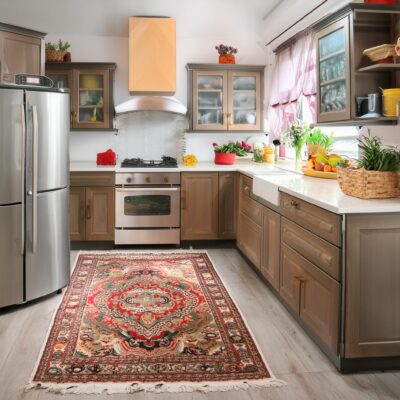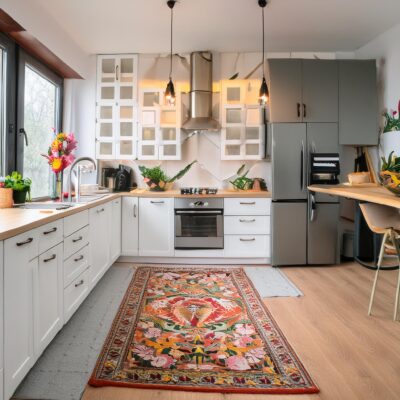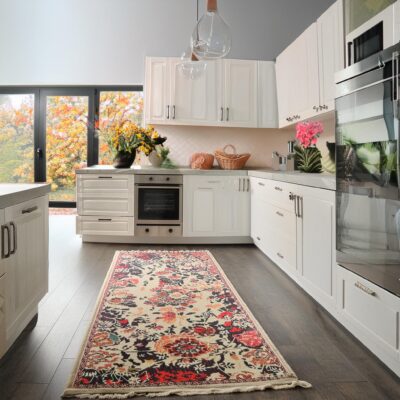Handmade hand-knotted oriental rugs from Kashmir are not just floor coverings; they are pieces of art that encapsulate centuries of tradition, craftsmanship, and culture.
These rugs, known for their intricate designs and unparalleled quality, have fascinated collectors and enthusiasts around the world. Here are five fun facts that delve into the unique world of Kashmir’s handmade hand-knotted oriental rugs .
At our World Trade Centre; Mumbai showroom, we have ready in stock 2000+ rugs, each of them being unique and for all the rooms in a bespoke home.
We rugs crafted for living rooms, bedrooms, dining rooms as well as corridors along with special rugs that can be displayed as wall hangings.
Handmade prayer rugs are crafted with care, ensuring each piece is unique and rich in cultural heritage.
If you’re evaluating rugs for your home, this checklist will help you spot genuine pieces: Original Kashmiri Carpets.
Looking for specific rugs for creating the perfect acoustic experience for your home theatre? Check out these rugs for home theatre.
Elevate your living space with our exclusive collection of handmade hand-knotted rugs for SOHO, meticulously crafted by skilled artisans.
In Mumbai, the art of oriental carpets shopping is elevated by the guarantee of an authentication certificate for each unique design.
When choosing floor coverings, understanding the difference between a carpet and a rug can help you decide which option best suits your space .
Want your living space to feel both peaceful and stylish? Discover how minimalist textures and bold patterns are redefining rug trends in 2025.
There are 5 oriental rugs myths that often mislead buyers when choosing the perfect piece for their home
The budget for an Oriental carpet can vary greatly depending on the size, material, and intricacy of the design. For a high-quality piece, you should plan to spend anywhere from $500 to $10,000 or more.
5 Fun Facts »
1. A Tradition Rooted in History:
The history of rug making in Kashmir dates back to the 15th century, introduced by the Mughal Emperor Akbar, who brought Persian craftsmen to India. These craftsmen passed on their skills to the local weavers, creating a unique blend of Persian and Indian artistry. The techniques and designs developed over centuries, resulting in the distinctive Kashmiri rugs we see today.
Kashmiri rugs are renowned for their Persian-inspired motifs, often featuring intricate floral patterns, medallions, and paisleys. The weavers have preserved these traditional designs while also incorporating local influences, creating a fusion of styles that is uniquely Kashmiri. The knowledge and skills required to create these masterpieces are passed down through generations, ensuring that each rug is a continuation of a long-standing cultural heritage.
2. The Art of Hand-Knotting:
One of the most fascinating aspects of these rugs is the meticulous process of hand-knotting. Each rug is created by tying individual knots on a loom, a labor-intensive process that can take several months to complete, depending on the rug’s size and complexity. The density of knots, measured in knots per square inch (KPSI), determines the rug’s quality and durability. A higher KPSI indicates a finer, more intricate rug.
Weavers use either the Persian or Turkish knotting technique. The Persian knot, also known as the Senneh knot, is asymmetrical and allows for more intricate patterns. The Turkish knot, or Ghiordes knot, is symmetrical and produces a more durable weave. Regardless of the technique used, the precision and skill required are immense, and it is this hand-knotted craftsmanship that gives these rugs their unparalleled beauty and longevity.
3. Natural Dyes and Eco-Friendly Practices:
Kashmiri rugs are celebrated not only for their designs but also for their vibrant colors. Traditionally, the wool and silk used in these rugs are dyed using natural dyes extracted from plants, minerals, and insects. Indigo, madder root, pomegranate, and cochineal are just a few sources of the rich hues that adorn these rugs. Natural dyes are prized for their ability to produce deep, lasting colors that age gracefully over time.
The use of natural dyes is part of a broader commitment to eco-friendly practices in Kashmiri rug making. Many weavers continue to use traditional dyeing methods that minimize environmental impact. Additionally, the primary materials used—wool and silk—are renewable resources. This sustainable approach not only preserves the environment but also ensures that each rug is a healthy, non-toxic addition to the home.
4. Symbolism in Designs:
Every element in a Kashmiri rug’s design has a meaning, often rooted in cultural and spiritual symbolism. The motifs and patterns tell stories, convey beliefs, and reflect the natural beauty of the region. For instance, the boteh or paisley motif, a common element in these rugs, symbolizes life and eternity. The tree of life pattern represents immortality and the connection between heaven and earth.
We have a detailed article on symbols and motiffs used in the oriental rugs.
Geometric patterns often signify protection and strength, while floral designs celebrate the natural world and its beauty. Each weaver brings their own interpretation to these traditional motifs, making every rug a unique piece of art. The symbolic nature of the designs adds a layer of depth and meaning to the aesthetic appeal of the rugs, making them not just decorative items but also cultural artifacts.
5. The Global Appeal of Kashmiri Rugs:
Despite their deep roots in Kashmiri culture, these rugs have a global appeal that transcends borders. Collectors and interior designers around the world covet them for their craftsmanship, beauty, and durability. The rugs are versatile and can complement a variety of decor styles, from traditional to contemporary. Their rich history and cultural significance add an element of storytelling to any space they adorn.
In recent years, the demand for Kashmiri rugs has led to collaborations between traditional weavers and contemporary designers. This fusion has resulted in innovative designs that maintain the essence of traditional craftsmanship while appealing to modern tastes.
These collaborations have also helped bring Kashmiri rugs to a broader audience, ensuring that the ancient art of hand-knotted rug making continues to thrive in the modern world.
Kitchen Rugs (Creative Visualisation) »
Conclusion
Handmade hand-knotted oriental rugs from Kashmir are more than just exquisite floor coverings; they are a testament to the rich cultural heritage, skilled craftsmanship, and sustainable practices of the region.
Each rug is a unique creation, woven with history, symbolism, and artistry. From the meticulous process of hand-knotting to the use of natural dyes and meaningful designs, these rugs are truly woven wonders that captivate the imagination and enhance the beauty of any space they grace.
By appreciating these five fun facts, one gains a deeper understanding and admiration for the intricate world of Kashmiri rug making.








